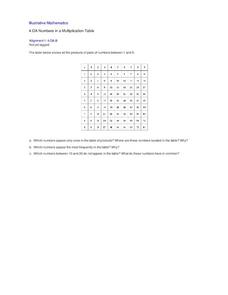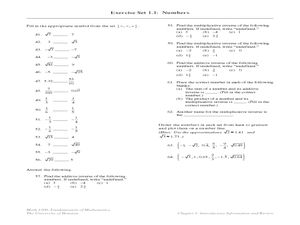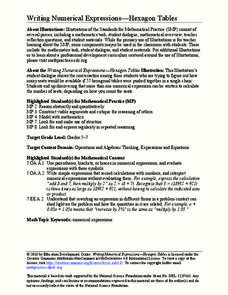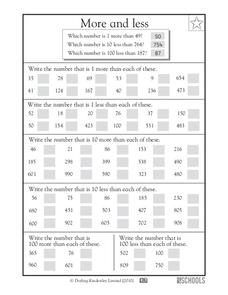Curated OER
Identifying Patterns
Although this fractions exercise may seem difficult at first, it's really quite simple and intended for beginners to mixed numbers. Scholars complete 15 number sequences by adding two or three mixed numbers or decimal numbers. However,...
EngageNY
Even and Odd Numbers
Even or not, here I come. Groups investigate the parity of products and sums of whole numbers in the 17th lesson in a series of 21. Using dots to represent numbers, they develop a pattern for the products of two even numbers; two odd...
Math Flix
MathFLIX Challenge: Multiplying and Dividing Fractions
First, math majors compare the multiplication and division of unit fractions and whole numbers. They look for patterns, and then apply their knowledge to an array of multiplication and division problems, all involving fractions and...
Math Mammoth
Add & Subtract Whole Hundreds 1
In this mathematics worksheet, 3rd graders compare the problem 2700 plus 200 to the problem 27 plus 2 and explain their reasoning. Then they notice the patterns for each of the problems and continue them.
Curated OER
Patterns in the Multiplication Table
Explore patterns in the multiplication table in order to deepen your third graders' understanding of this essential skill. Implement this activity as a whole-class lesson, allowing students to work in pairs or small groups to support...
Illustrative Mathematics
Numbers in a Multiplication Table
Identifying patterns is a crucial skill for all mathematicians, young and old. Explore the multiplication table with your class, using patterns and symmetry to teach about square numbers, prime numbers, and the commutative and identity...
Curated OER
Fractions and Recipes
Learners, working with their parents in real world situations, calculate to complete three word problems associated with multiplying and dividing fractions.
Computer Science Unplugged
Count the Dots – Binary Numbers
Did you know you can send a message using only zeroes and ones? This interactive resource presents an introduction to binary numbers. Through code cards, pupils learn to convert binary numbers to decimal numbers.
Virginia Department of Education
Complex Numbers
Build on your class' understanding of real numbers as they begin working with complex numbers. Pupils begin with an exploration of i and the patterns in the powers of i. After developing a definition for i, they...
Curated OER
Patterns
In this patterns worksheet, students problem solve the answers to six mathematical word problems involving patterns with whole numbers and fractions.
Curriculum Corner
Digraph Word Hunt
Support young learners with developing their spelling skills and ready fluency with this simple graphic organizer. Focusing on the four consonant digraphs /th/, /ch/, /sh/, and /wh/, students dig through their independent reading books...
Curated OER
Working With Whole Numbers
In this whole number worksheet, students write numbers in words, write words in numbers, circle the largest of 3 numbers, determine place value, solve problems using all 4 operations complete number patterns, find factors and solve word...
Curated OER
Fractions Dividing By Whole Numbers
In this math worksheet, students examine the patterns in the pie graphs and identify the common one. They also divide the fractions by whole numbers for the set of problems.
Curated OER
Exploring Real Numbers
In this algebra worksheet, 11th graders classify numbers as rational, irrational, integral and whole. They solve the equations and graph i ton a number line. There are 26 questions with an answer key.
Curated OER
Multiplying By Whole Tens
In this multiplying worksheet, pupils count by tens, write the rule for multiplying by ten, and then multiply numbers by ten. Examples and explanations are given prior to the exercise. This two-page worksheet contains approximately 30...
Maths Blog
Adding/Subtracting Whole Numbers in Your Head
Exercise those mental math muscles! This worksheet contains 10 addition and 10 subtraction problems which require learners to compute sums or differences in their heads. A quick review at the top of the page provides a strategy based on...
Curated OER
Adding Tenths
In this mathematics instructional activity, 4th graders identify what is missing from the whole 1 in each problem. Then they draw a number line from 0 to 2 with tick marks at every tenth place. Students also add each decimal and write...
Virginia Department of Education
Integers: Addition and Subtraction
Young mathematicians construct their own understanding of integers with an inquiry-based math lesson. Using colored chips to represent positive and negative numbers, children model a series of addition and subtraction problems as...
Curated OER
Numbers 1.1
For this numbers 1.1 worksheet, learners solve 64 problems about all kinds of numbers: rational, irrational, prime, composite, square roots, fractions, decimals.
Northern Arizona University
Adding and Subtracting Fractions
Pattern blocks and shapes demonstrate how to add and subtract fractions. By aligning blocks with different shapes, learners figure out how to create a whole, and then how to add and delete parts from that whole.
Curated OER
The oa Sound
Explore spelling patterns with this multi-step worksheet featuring the /oa/ sound. Learners read a brief introduction explaining that this sound can be achieved by three different vowel combinations. They complete a different...
Education Development Center
Writing Numerical Expressions—Hexagon Tables
Explore a basic pattern to practice writing expressions. In collaborative groups, learners examine a contextual pattern and write an expression to model it. The task encourages groups to describe the pattern in multiple ways.
Curated OER
More and Less
Mental mathematicians add and subtract 1, 10, and 100 from sets of numbers. Each set of one, two and three-digit numbers gives scholars a chance to practice their addition and subtraction skills. There are 62 whole numbers in all. What...
Curated OER
Counting by 2s, part 2
Two, four, six, eight...can your scholars count by twos? They fill in missing numbers in 18 number sequences, all of which require skip counting by twos. Some begin on an even number and others odd, however all of these are whole...























